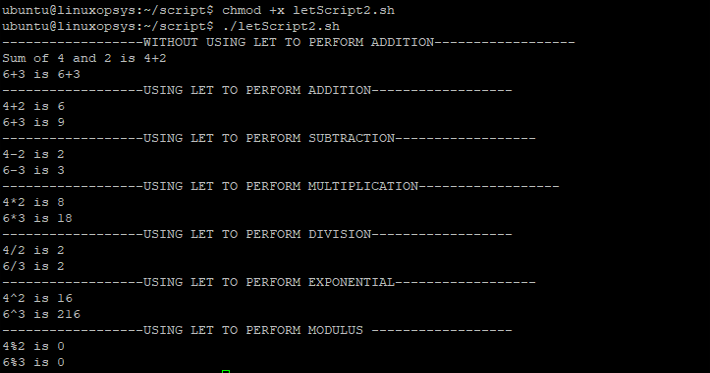In bash, all variables are treated as strings. You cannot perform arithmetic operations on variables as you would normally do in other programming languages since bash interprets them as strings. To overcome this, bash has a built-in tool named let. Using the let command, you can declare a variable and perform arithmetic operations during the assignment.
Prerequisites
- A text editor
- Access to a terminal
Bash let
Bash let is a simple built-in utility available on all Linux systems. It directs bash to evaluate arithmetic expressions. Using this command you can perform bitwise operations as well. Your variable computations do not expect you to add the $ symbol to represent variables.
Here’s the syntax:
let <expression>Where expression is the expression to be carried out.
How to use bash let
In this section, we are going to learn how we can make use of the let command to evaluate strings as numbers. We will carry out arithmetic, bitwise, and increments and decrements operations on variables using let. We will also understand the scope of the variables.
1. Evaluate Strings as Numbers
The bash variables, by default, are of strings datatype. To carry out the conversion and evaluate them as numbers, we can use the let command.
Let’s create a script (letScript1.sh) by opening your favorite editor. Put the following contents and save it:
#!/bin/bash
let i=5
echo i is $i
j=10 k=j
echo Without let j is $j and k is $k #Without let k will store the string value j
let j=10 k=j
echo With let j is $j and k is $k #Assigning the same value to another variable
The above example assigns a numeric value to the variable. Another interesting thing to note is that let command allows us to assign the same value to a new variable.

2. Basic arithmetic operations
The basic arithmetic operators are:
- Addition (+)
- Subtraction (-)
- Multiplication (*)
- Division (/)
- Exponential (**)
- Modulus (%)
Example:
#!/bin/bash
let a=4
let b=2
c=6
d=3
echo "------------------WITHOUT USING LET TO PERFORM ADDITION------------------"
result=$a+$b
echo Sum of $a and $b is $result
#Alternatively
result2=$c+$d
echo $c+$d is $result2
echo "------------------USING LET TO PERFORM ADDITION------------------"
let result=$a+$b
echo $a+$b is $result
#Alternatively we can use let as follows
let result2=$c+$d
echo $c+$d is $result2
echo "------------------USING LET TO PERFORM SUBTRACTION------------------"
let result=$a-$b
echo $a-$b is $result
#Alternatively we can use let as follows:
let result2=$c-$d
echo $c-$d is $result2
echo "------------------USING LET TO PERFORM MULTIPLICATION------------------"
let result=$a*$b
echo $a*$b is $result
#Alternatively we can use let as follows:
let result2=$c*$d
echo $c*$d is $result2
echo "------------------USING LET TO PERFORM DIVISION------------------"
let result=$a/$b
echo $a/$b is $result
#Alternatively we can use let as follows:
let result2=$c/$d
echo $c/$d is $result2
echo "------------------USING LET TO PERFORM EXPONENTIAL------------------"
let result=$a**$b
echo $a^$b is $result
#Alternatively we can use let as follows:
let result2=$c**$d
echo $c^$d is $result2
echo "------------------USING LET TO PERFORM MODULUS ------------------"
let result=$a%$b
echo $a%$b is $result
#Alternatively we can use let as follows:
let result2=$c%$d
echo $c%$d is $result2
As we can see, without using the let command, bash will interpret the variables as strings and will print the expression without evaluating it. With let, we can perform the basic arithmetic functionalities. We can either explicitly declare the variables using let and perform the operations or simply use let to declare the result where the expression evaluation takes place.

3. Increments and Decrements Operators
The increments and decrements can be categorized into 3 categories:
- Post-increment(i++) and Post-decrement(i--): Using let, we can interpret the numerical value of the variable then increase or decrease by 1.
- Pre-increment(++i) and Pre-decrement(--i): When used with let, this operation results in an increase or a decrease of the value by 1 and then the interpretation of the numeric variable takes place.
- Unary plus(+i) and Unary minus(-i): This operation appends a plus (+) or a minus (-) sign to the numeric value. It other words, the expression is multiplied by 1 or -1
Example:
#!/bin/bash
echo "------------------POST------------------"
let a=4
let b=102
let z=a++
echo $a $z
let y=b--
echo $b $y
echo "------------------PRE------------------"
let a=4
let b=102
let z=++a
echo $a $z
let y=--b
echo $b $y
echo "------------------UNARY------------------"
let a=4
let b=-102
let z=-a
echo $a $z
let y=+b
echo $b $y
From the above example we can see increments and decrements can be performed with the help of let command. With post operations, variables z and y are assigned the values of a and b respectively before the increment has happened. However, with pre operations, the values are altered after which they get stored in the variables z and y.

4. Bitwise operations
The following bitwise operators can be used with let.
- Bitwise negation(~)
- Bitwise shift left
- Bitwise shift right
- Bitwise AND
- Bitwise OR
- Bitwise XOR
Here’s an example:
#!/bin/bash
let a=4 #000100
let b=2 #000010
echo "------------------ USING LET FOR BITWISE NEGATION------------------"
let result=~a
echo Negation of $a is $result
echo "------------------ USING LET FOR LEFT SHIFT------------------"
let "result=a<<2"
echo Left shift of $a is $result
echo "------------------ USING LET FOR RIGHT SHIFT------------------"
let "result=a>>2"
echo Right shift of $a is $result
echo "------------------ USING LET FOR BITWISE AND------------------"
let "result=a&b"
echo $a AND $b is $result
echo "------------------ USING LET FOR BITWISE OR------------------"
let "result=a|b"
echo $a OR $b is $result
echo "------------------ USING LET FOR BITWISE XOR------------------"
let "result=a^ b"
echo $a XOR $b is $result
Using let we perform bitwise operations. The binary value of 4 is 00000100. Negation will flip 4 to a binary value of 11111011, which is represented as -5 in 2’s complement. A single bitwise left shift is multiplication by 2. Doing it twice results in multiplication by 4. Similarly, a single right shift results in the division of the number by 2.
Further, a bitwise AND compares two bits and returns 1 if both are 1, otherwise 0.
A bitwise OR also does the bitwise comparison, returning 1 even if one of the bits is 1, otherwise 0.
XOR returns 0 if two bits are similar otherwise 1
2 in binary= 00000010
4 in binary = 00000100
Negation of 4 = ~4 = 11111011 = -5
2 Bitwise left shift of 4 = 4<<2 = 00000100 -> 00001000-> 00010000 = 16
2 Bitwise right shift of 4 = 4 >>2 = 00000100 -> 00000010-> 00000001 = 1
Bitwise 4 and 2 = 4&2 = 00000100 & 00000010 =00000000 = 0
Bitwise 4 or 2= 4|2 = 00000100 | 00000010 =00000110 = 6
Bitwise 4 xor 2= 4^2 = 00000100 ^ 00000010 =00000110 = 6

5. Scope of variables
The let command creates a local scope for the variables on which it acts. If you have any predefined variable existing, it will get overwritten. When a variable set in its local scope and its effective value is not yet established, the value does not update when we evaluate it.
Example:
#!/bin/bash
echo "------------------ ONE------------------"
j=10
let i=5
let j=i
echo i and j are $i and $j
echo "------------------ TWO------------------"
let i=5
let inc=i++
echo i and inc are $i and $inc
echo "------------------ THREE------------------"
let i=5
let inc=++i
echo i and inc are $i and $inc
The variable j was initialized to 10. However, after using let command, it was overwritten to the value stored in the variable i.
In the next case, we can see the value of inc does not increase. However, in the final case, the evaluation of i happened before the assignment to the variable inc. As a result both i and inc hold the value 6.

Conclusion
Takeaway points from this tutorial
- All bash variables are strings so to process them as numeric values, bash offers a simple command called let.
- It is a pretty useful bash functionality to carry out arithmetic and bitwise operations on numbers.
- We have also learned about the scope of the variables in detail.




Comments